The Dr. Laurie L. Consaul Herbarium
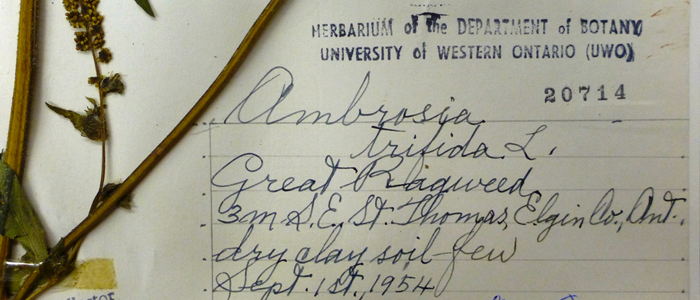
The Dr. Laurie L. Consaul Herbarium (UWO) comprises over 42,000 specimens of vascular plants, with best representation of the plants of southwestern Ontario, and sparse coverage of the remainder of Canada, the United States and other parts of the world. In addition there are several thousand specimens of Crataegus (Rosaceae) from all parts of North America including Mexico as well as small bryophyte, fungi and lichen collections.
The herbarium lies in the centre of the Carolinian Zone of southwestern Ontario, floristically the richest region of Canada. At least one specimen of most of the 2,500 or so native and non-native plants found growing in the wild in the surrounding area is represented in the herbarium. Collections at Western have supported the production of regional checklists for the Carolinian Zone including Middlesex, Oxford and Elgin Counties (Oldham et al., 1991), Lambton County (Tiedje & Tiedje, 1994) and Elgin County (Stewart & James, 1969). The herbarium has partnerships with Carolinian Canada to produce educational and outreach material on species and habitats at risk in the Carolinian Zone.
Faculty, students and other visitors are welcome to visit the herbarium and use its facilities. Occasional introductory workshops are held on the plant collecting, using a herbarium and plant identification. Regularly updated collection databases can be accessed for the lichen collection at the Consortium of North American Lichen Herbaria website; the vascular plant specimen data is available through Canadensys. For other inquiries or more information contact the curator, Dr. R. Greg Thorn or Herbarium Assistant, Kris Mendola.
What is a Herbarium?
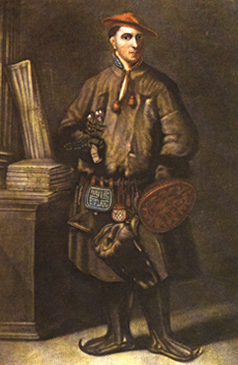

Carolus Linnaeus (1707-78) (left); A Herbarium Specimen of Goldie's Fern (right)
A herbarium is basically a library or museum of dried plant specimens. Early herbalists found that pressing plants, drying them flat and fixing them to paper was an excellent way of preserving them for study. It meant that plants were available out of season. Pressed plants if properly cared for will maintain most of their salient features for hundreds of years.
The first herbarium is attributed to Luca Ghini (1490?-1556), but by the mid 1500s the art of herbarium-making was disseminated all over Europe. The herbarium of Gherards Cibo, a pupil of Ghini, was started in 1532 and still exists today.
Originally herbarium pages were bound into a book. It was Carolus Linnaeus (1707-78), the founder of the modern system of scientific plant names, who departed from the convention of the day. He introduced the idea of mounting specimens on single sheets and storing them flat in cabinets. This became the general practice by the mid 18th century and is still the standard today.
History
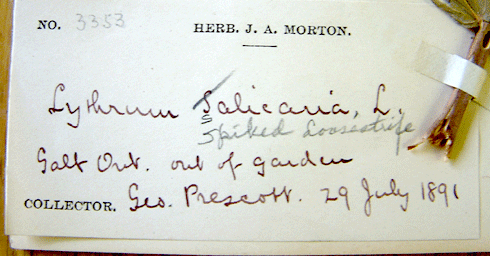
Early Herbarium Label from the Morton Collection

The Western University Herbarium was founded in 1919. At a meeting of the Board of Governors on 12 November, Dean Sherwood W. Fox announced that “The Morton Collection of botanical specimens is now in the biological laboratories”. J.A. Morton, who donated his plant specimens was a lawyer from Wingham, Ontario, and an avid plant collector.
By the mid 1940’s, when the collection was first formally catalogued, the number of specimens had risen to about 6,200, plus some 5000 duplicate specimens available for exchange with other herbaria.
Until the early 1960s the herbarium remained very small and a large number of specimens were unmounted. In 1961 Dr James B. Phipps, newly hired as faculty member in the Department of Plant Sciences, was appointed as Curator and remained in that position until he retired in 2000.
In the summer of 1963 the first paid staff member Miss E. Hamill was hired as a summer technician to help with mounting and filing specimens. From then on accession records were kept of specimens deposited in the herbarium. In 1965, the first permanent position of Herbarium Assistant was created and held by Mrs. M. Orlóci.
The size of the herbarium collection grew to 22,000 by 1969, partly as a result of the purchase of the L.E. James collection. The number of specimens has increased steadily since then and now stands at about 42,000 vascular plant accessions plus an additional 10,000 or so Crataegus specimens in the Phipps Research Collection.
From 2000 until the summer of 2003 Dr. R. Greg Thorn, an Associate Professor in the Department of Biology, filled the position of Curator. Vicky Lightfoot continued as Herbarium Assistant, a position she had held since 1990.
In 2003 both Greg Thorn and Vicky Lightfoot left the Herbarium for other roles in the Department of Biology. Dr. Jane M. Bowles was hired as Curator in December 2003. This was the first time someone was hired specifically to the position of Curator. In February 2004 Sandra Mackin became the new Herbarium Assistant. Jane Bowles was an effective curator as well as champion of local plant conservation, until her death in 2013. The courtyard in the Biological & Geological Sciences building was named in her honour; this space is just outside of the herbarium. In 2014 Greg Thorn returned as curator, a position he holds in addition to his regular research, teaching, and administrative duties.
In 2019 the Herbarium was renamed the Dr. Laurie L. Consaul Herbarium. Laurie Consaul was a passionate researcher who had worked as an assistant curator of the Herbarium during the late 1980's. The Canadian Field-Naturalist published a tribute to her in 2013.
Taxonomic research will remain an important activity at the Western Herbarium, but more emphasis will be given in the future to plant conservation - documenting and monitoring regional plant diversity and distributions – and to teaching and outreach.
Roles of Herbaria
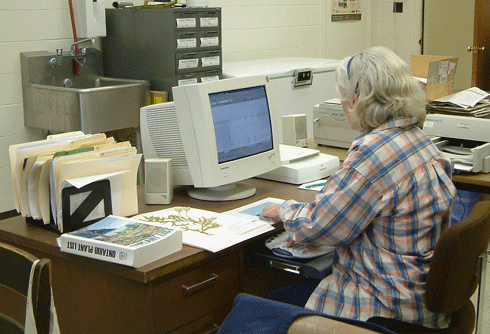
Entering specimen information into a database. [photo: Jane Bowles]
Collections of plant specimens may serve one or more of a variety of purposes. Some of these may include the following.
Taxonomic Research: Taxonomy is the science of identification, naming and classifying. Specimens in a herbarium provide a sample of materials that can be used to prepare floras and monographs. Most herbaria have an international program of borrowing and lending herbarium specimens to other institutions. At Western Professor Emeritus J.B. Phipps, who studies the genus Crataegus (Hawthorns) and other member of the order Maloideae, does most of the taxonomic research.

Storage of Reference Material and Vouchers: Herbarium specimens are dried and stuck to cards and then stored in insect-proof cabinets. This allows plants to be preserved for long periods. Vouchers allow future researchers to document the authenticity of the material on record. The most important vouchers are type specimens - individual specimens designated by the original author when a new taxon is described. Other vouchers are used to document specimens used in research. They may also document the record of a plant from a particular locality, or be drawn or photographed to represent a species in a monograph or flora. An efficient referencing system allows any specimen to be retrieved quickly.
Databank for biodiversity: Loss of biodiversity has been named as one of the major crises facing the world today. Specimens stored in herbaria provide documentation of biodiversity. Herbarium records may be used to create range maps and plot historic and current species distributions.
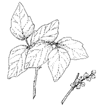
Public Outreach: The staff of the herbarium often provide information about poisonous plants, medicinal plants, weeds, ornamentals, species at risk and so on. Doctors, farmers, government officials, horticulturists, landscape architects, environmental consultants, foresters, landowners, students and teachers are among the many people who may make use of the herbarium.
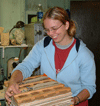
Teaching: The material in a herbarium may be used to teach many subjects such as plant taxonomy, ecology, biogeography, history, biochemistry and ethnobotany.
Plant identification: Specimens of unknown plants may be brought to the herbarium for identification. Unknown plants can be matched against specimens in the herbarium.
Contact
- Location: BGS Room 0121
- Hours: Monday and Wednesday 8:30-4:00 or by appointment.
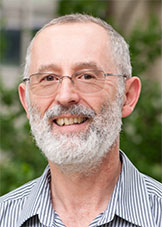 |
Curator: Dr. R. Greg Thorn
|
 |
Curatorial Assistant: Kris Mendola
|

